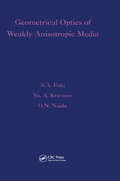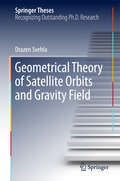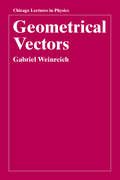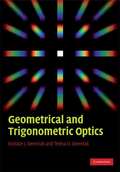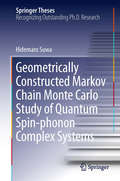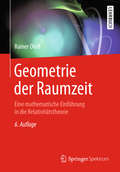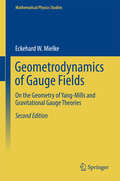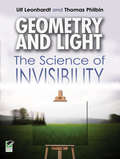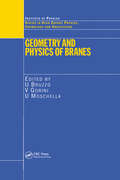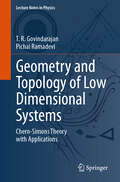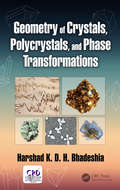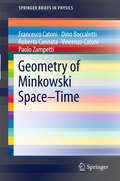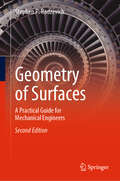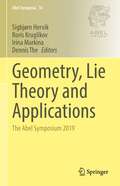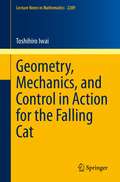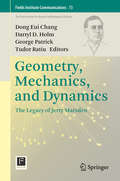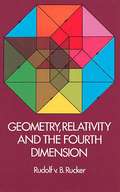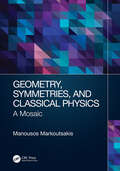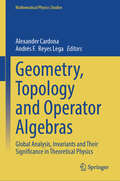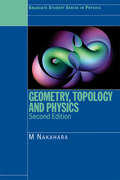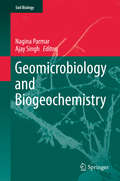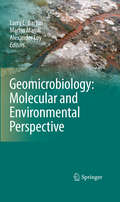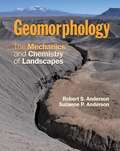- Table View
- List View
Geometrical Optics of Weakly Anisotropic Media
by AA FukiUntil recently, there was no effective method for describing waves in weakly anisotropic inhomogeneous media. The method of quasi-isotropic approximation (QIA) of geometrical optics was developed to overcome this problem. The QIA approach bridges the gap between geometrical optics of isotropic media (Rytov method) and that of anisotropic media (Courant-Lax approach). thus providing a complete picture of the geometrical optics of inhomogeneous media. The book explores recent developments in QIA and describes the application of the theory to different branches of wave physics, from plasma physics. quantum physics and ionospheric radio wave propagation to acoustics, optics and astrophysics. The authors present some modifications and generalisations of QIA equations, and look at electromagnetic waves and optical and acoustic effects in weakly anisotropic media, as well as geometrical optics of 3D inhomogeneous media. The book closes with some quantum mechanical analogies. This is an up-to-the minute exposition of the latest developments in an important new area, written by authors of outstanding international reputation. A rich source of both theoretical methods and practical applications, this book covers a wide range of problems of general physical significance and will be of interest to those working in optics, acoustics, electrical engineering, radio engineering and wave propagation through plasma.
Geometrical Theory of Satellite Orbits and Gravity Field (Springer Theses)
by Drazen SvehlaThis book on space geodesy presents pioneering geometrical approaches in the modelling of satellite orbits and gravity field of the Earth, based on the gravity field missions CHAMP, GRACE and GOCE in the LEO orbit. Geometrical approach is also extended to precise positioning in space using multi-GNSS constellations and space geodesy techniques in the realization of the terrestrial and celestial reference frame of the Earth. This book addresses major new developments that were taking place in space geodesy in the last decade, namely the availability of GPS receivers onboard LEO satellites, the multitude of the new GNSS satellite navigation systems, the huge improvement in the accuracy of satellite clocks and the revolution in the determination of the Earth's gravity field with dedicated satellite missions.
Geometrical Vectors (Chicago Lectures in Physics)
by Gabriel WeinreichEvery advanced undergraduate and graduate student of physics must master the concepts of vectors and vector analysis. Yet most books cover this topic by merely repeating the introductory-level treatment based on a limited algebraic or analytic view of the subject.Geometrical Vectors introduces a more sophisticated approach, which not only brings together many loose ends of the traditional treatment, but also leads directly into the practical use of vectors in general curvilinear coordinates by carefully separating those relationships which are topologically invariant from those which are not. Based on the essentially geometric nature of the subject, this approach builds consistently on students' prior knowledge and geometrical intuition. Written in an informal and personal style, Geometrical Vectors provides a handy guide for any student of vector analysis. Clear, carefully constructed line drawings illustrate key points in the text, and problem sets as well as physical examples are provided.
Geometrical and Trigonometric Optics
by Eustace Dereniak Teresa D. DereniakThis new and up-to-date book covers the modern geometrical aspects of optics, which is the fundamental level of understanding the technology. Beginning with how light is generated and how fast it travels, the book discusses how materials interact with light, how various materials affect the velocity of light, and the ramifications of change in the speed of light. The concept of the index of refraction, and how it is used with Snell's law to produce image forming systems, is developed. An ideal textbook for advanced undergraduate level courses in geometrical optics, this book will also interest those wanting to learn the concepts and theory of geometrical optics. Each chapter contains worked examples, and there are exercises to reinforce the reader's understanding of material.
Geometrically Constructed Markov Chain Monte Carlo Study of Quantum Spin-phonon Complex Systems
by Hidemaro SuwaIn this thesis, novel Monte Carlo methods for precisely calculating the critical phenomena of the effectively frustrated quantum spin system are developed and applied to the critical phenomena of the spin-Peierls systems. Three significant methods are introduced for the first time: a new optimization algorithm of the Markov chain transition kernel based on the geometric weight-allocation approach, the extension of the worm (directed-loop) algorithm to nonconserved particles, and the combination with the level spectroscopy. Utilizing these methods, the phase diagram of the one-dimensional XXZ spin-Peierls system is elucidated. Furthermore, the multi-chain and two-dimensional spin-Peierls systems with interchain lattice interaction are investigated. The unbiased simulation shows that the interesting quantum phase transition between the 1D-like liquid phase and the macroscopically-degenerated dimer phase occurs on the fully-frustrated parameter line that separates the doubly-degenerated dimer phases in the two-dimensional phase diagram. The spin-phonon interaction in the spin-Peierls system introduces the spin frustration, which usually hinders the quantum Monte Carlo analysis, owing to the notorious negative sign problem. In this thesis, the author has succeeded in precisely calculating the critical phenomena of the effectively frustrated quantum spin system by means of the quantum Monte Carlo method without the negative sign.
Geometrie der Raumzeit: Eine mathematische Einführung in die Relativitätstheorie
by Rainer OloffDie Relativitätstheorie ist in ihren Kernaussagen nicht mehr umstritten, gilt aber noch immer als kompliziert und nur schwer verstehbar. Das liegt unter anderem an dem aufwendigen mathematischen Apparat, der schon zur Formulierung ihrer Ergebnisse und erst recht zum Nachvollziehen der Argumentation notwendig ist. In diesem Lehrbuch werden die mathematischen Grundlagen der Relativitätstheorie systematisch entwickelt, das ist die Differentialgeometrie auf Mannigfaltigkeiten einschließlich Differentiation und Integration. Die Spezielle Relativitätstheorie wird als Tensorrechnung auf den Tangentialräumen dargestellt. Die zentrale Aussage der Allgemeinen Relativitätstheorie ist die Einstein'sche Feldgleichung, die die Krümmung zur Materie in Beziehung setzt. Ausführlich werden die relativistischen Effekte im Sonnensystem einschließlich der Schwarzen Löcher behandelt. Dieser Text richtet sich an Studierende der Physik und der Mathematik und setzt nur Grundkenntnisse aus der klassischen Differential- und Integralrechnung und der Linearen Algebra voraus. Für die neue Auflage wurde das Buch durchgesehen und alle bekannt gewordenen Fehler korrigiert.
Geometrodynamics of Gauge Fields: On the Geometry of Yang-Mills and Gravitational Gauge Theories (Mathematical Physics Studies)
by Eckehard W. MielkeThis monograph aims to provide a unified, geometrical foundation of gauge theories of elementary particle physics. The underlying geometrical structure is unfolded in a coordinate-free manner via the modern mathematical notions of fibre bundles and exterior forms. Topics such as the dynamics of Yang-Mills theories, instanton solutions and topological invariants are included. By transferring these concepts to local space-time symmetries, generalizations of Einstein's theory of gravity arise in a Riemann-Cartan space with curvature and torsion. It provides the framework in which the (broken) Poincaré gauge theory, the Rainich geometrization of the Einstein-Maxwell system, and higher-dimensional, non-abelian Kaluza-Klein theories are developed. Since the discovery of the Higgs boson, concepts of spontaneous symmetry breaking in gravity have come again into focus, and, in this revised edition, these will be exposed in geometric terms. Quantizing gravity remains an open issue: formulating it as a de Sitter type gauge theory in the spirit of Yang-Mills, some new progress in its topological form is presented. After symmetry breaking, Einstein’s standard general relativity with cosmological constant emerges as a classical background. The geometrical structure of BRST quantization with non-propagating topological ghosts is developed in some detail.
Geometry and Light: The Science of Invisibility (Dover Books on Physics)
by Ulf Leonhardt Thomas PhilbinThe science of invisibility combines two of physics' greatest concepts: Einstein's general relativity and Maxwell's principles of electromagnetism. Recent years have witnessed major breakthroughs in the area, and the authors of this volume -- Ulf Leonhardt and Thomas Philbin of Scotland's University of St. Andrews -- have been active in the transformation of invisibility from fiction into science. Their work on designing invisibility devices is based on modern metamaterials, inspired by Fermat's principle, analogies between mechanics and optics, and the geometry of curved space. Suitable for graduate students and advanced undergraduates of engineering, physics, or mathematics, and scientific researchers of all types, this is the first authoritative textbook on invisibility and the science behind it. The book is two books in one: it introduces the mathematical foundations -- differential geometry -- for physicists and engineers, and it shows how concepts from general relativity become practically useful in electrical and optical engineering, not only for invisibility but also for perfect imaging and other fascinating topics. More than one hundred full-color illustrations and exercises with solutions complement the text.
Geometry and Physics of Branes
by Ugo BruzzoBranes are solitonic configurations of a string theory that are represented by extended objects in a higher-dimensional space-time. They are essential for a comprehension of the non-perturbative aspects of string theory, in particular, in connection with string dualities. From the mathematical viewpoint, branes are related to several important theo
Geometry and Topology of Low Dimensional Systems: Chern-Simons Theory with Applications (Lecture Notes in Physics #1027)
by T. R. Govindarajan Pichai RamadeviThis book introduces the field of topology, a branch of mathematics that explores the properties of geometric space, with a focus on low-dimensional systems. The authors discuss applications in various areas of physics. The first chapters of the book cover the formal aspects of topology, including classes, homotopic groups, metric spaces, and Riemannian and pseudo-Riemannian geometry. These topics are essential for understanding the theoretical concepts and notations used in the next chapters of the book. The applications encompass defects in crystalline structures, space topology, spin statistics, Braid group, Chern-Simons field theory, and 3D gravity, among others. This self-contained book provides all the necessary additional material for both physics and mathematics students. The presentation is enriched with examples and exercises, making it accessible for readers to grasp the concepts with ease. The authors adopt a pedagogical approach, posing many unsolved questions in simple situations that can serve as challenging projects for students. Suitable for a one-semester postgraduate level course, this text is ideal for teaching purposes.
Geometry of Crystals, Polycrystals, and Phase Transformations
by Harshad K. Bhadeshia<p>Organized into a two-part structure aimed at readers of differing experience levels, Geometry of Crystals, Polycrystals, and Phase Transformations is accessible to both newcomers and advanced researchers within the field of crystallography. The first part of the text covers what any reader in the material sciences, physics, chemistry, earth sciences and natural sciences in general should know about crystallography. It is intentionally concise and covers sufficient material to form a firm foundation. <p>The second part is aimed at researchers and discusses phase transformations, deformations, and interface crystallography in depth. The phase transformations are limited to those dominated by crystallography. The entire book contains worked examples and uniquely deals not just with crystals but aggregates of crystals and solid-state transformations between crystals.</p>
Geometry of Minkowski Space-Time
by Dino Boccaletti Paolo Zampetti Vincenzo Catoni Roberto Cannata Francesco CatoniThis book provides an original introduction to the geometry of Minkowski space-time. A hundred years after the space-time formulation of special relativity by Hermann Minkowski, it is shown that the kinematical consequences of special relativity are merely a manifestation of space-time geometry. The book is written with the intention of providing students (and teachers) of the first years of University courses with a tool which is easy to be applied and allows the solution of any problem of relativistic kinematics at the same time. The book treats in a rigorous way, but using a non-sophisticated mathematics, the Kinematics of Special Relativity. As an example, the famous "Twin Paradox" is completely solved for all kinds of motions. The novelty of the presentation in this book consists in the extensive use of hyperbolic numbers, the simplest extension of complex numbers, for a complete formalization of the kinematics in the Minkowski space-time. Moreover, from this formalization the understanding of gravity comes as a manifestation of curvature of space-time, suggesting new research fields.
Geometry of Quantum States: An Introduction to Quantum Entanglement
by Ingemar Bengtsson Karol ŻyczkowskiQuantum information theory is a branch of science at the frontier of physics, mathematics, and information science, and offers a variety of solutions that are impossible using classical theory. This book provides a detailed introduction to the key concepts used in processing quantum information and reveals that quantum mechanics is a generalisation of classical probability theory. The second edition contains new sections and entirely new chapters: the hot topic of multipartite entanglement; in-depth discussion of the discrete structures in finite dimensional Hilbert space, including unitary operator bases, mutually unbiased bases, symmetric informationally complete generalized measurements, discrete Wigner function, and unitary designs; the Gleason and Kochen-Specker theorems; the proof of the Lieb conjecture; the measure concentration phenomenon; and the Hastings' non-additivity theorem. This richly-illustrated book will be useful to a broad audience of graduates and researchers interested in quantum information theory. Exercises follow each chapter, with hints and answers supplied.
Geometry of Surfaces: A Practical Guide for Mechanical Engineers
by Stephen P. RadzevichThis updated and expanded edition presents a highly accurate specification for part surface machining. Precise specification reduces the cost of this widely used industrial operation as accurately specified and machined part surfaces do not need to undergo costly final finishing. Dr. Radzevich describes techniques in this volume based primarily on classical differential geometry of surfaces. He then transitions from differential geometry of surfaces to engineering geometry of surfaces, and examines how part surfaces are either machined themselves, or are produced by tools with surfaces that are precisely machined. The book goes on to explain specific methods, such as derivation of planar characteristic curves based on Plücker conoid constructed at a point of the part surface, and that analytical description of part surface is vital for surfaces machined using CNC technology, and especially so for multi-axes NC machines. Providing readers with a powerful tool for analytical description of part surfaces machined on conventional machine tools and numerically controlled machines, this book maximizes understanding on optimal treatment of part surfaces to meet the requirements of today’s high tech industry.
Geometry, Lie Theory and Applications: The Abel Symposium 2019 (Abel Symposia #16)
by Sigbjørn Hervik Boris Kruglikov Irina Markina Dennis TheThis book consists of contributions from the participants of the Abel Symposium 2019 held in Ålesund, Norway. It was centered about applications of the ideas of symmetry and invariance, including equivalence and deformation theory of geometric structures, classification of differential invariants and invariant differential operators, integrability analysis of equations of mathematical physics, progress in parabolic geometry and mathematical aspects of general relativity.The chapters are written by leading international researchers, and consist of both survey and research articles. The book gives the reader an insight into the current research in differential geometry and Lie theory, as well as applications of these topics, in particular to general relativity and string theory.
Geometry, Mechanics, and Control in Action for the Falling Cat (Lecture Notes in Mathematics #2289)
by Toshihiro IwaiThe falling cat is an interesting theme to pursue, in which geometry, mechanics, and control are in action together. As is well known, cats can almost always land on their feet when tossed into the air in an upside-down attitude. If cats are not given a non-vanishing angular momentum at an initial instant, they cannot rotate during their motion, and the motion they can make in the air is vibration only. However, cats accomplish a half turn without rotation when landing on their feet. In order to solve this apparent mystery, one needs to thoroughly understand rotations and vibrations. The connection theory in differential geometry can provide rigorous definitions of rotation and vibration for many-body systems. Deformable bodies of cats are not easy to treat mechanically. A feasible way to approach the question of the falling cat is to start with many-body systems and then proceed to rigid bodies and, further, to jointed rigid bodies, which can approximate the body of a cat. In this book, the connection theory is applied first to a many-body system to show that vibrational motions of the many-body system can result in rotations without performing rotational motions and then to the cat model consisting of jointed rigid bodies. On the basis of this geometric setting, mechanics of many-body systems and of jointed rigid bodies must be set up. In order to take into account the fact that cats can deform their bodies, three torque inputs which may give a twist to the cat model are applied as control inputs under the condition of the vanishing angular momentum. Then, a control is designed according to the port-controlled Hamiltonian method for the model cat to perform a half turn and to halt the motion upon landing. The book also gives a brief review of control systems through simple examples to explain the role of control inputs.
Geometry, Mechanics, and Dynamics
by Dong Eui Chang Darryl D. Holm George Patrick Tudor RatiuThis book illustrates the broad range of Jerry Marsden's mathematical legacy in areas of geometry, mechanics, and dynamics, from very pure mathematics to very applied, but always with a geometric perspective. Each contribution develops its material from the viewpoint of geometric mechanics beginning at the very foundations, introducing readers to modern issues via illustrations in a wide range of topics. The twenty refereed papers contained in this volume are based on lectures and research performed during the month of July 2012 at the Fields Institute for Research in Mathematical Sciences, in a program in honor of Marsden's legacy. The unified treatment of the wide breadth of topics treated in this book will be of interest to both experts and novices in geometric mechanics. Experts will recognize applications of their own familiar concepts and methods in a wide variety of fields, some of which they may never have approached from a geometric viewpoint. Novices may choose topics that interest them among the various fields and learn about geometric approaches and perspectives toward those topics that will be new for them as well.
Geometry, Relativity and the Fourth Dimension
by Rudolf RuckerThis is a highly readable, popular exposition of the fourth dimension and the structure of the universe. A remarkable pictorial discussion of the curved space-time we call home, it achieves even greater impact through the use of 141 excellent illustrations. This is the first sustained visual account of many important topics in relativity theory that up till now have only been treated separately.Finding a perfect analogy in the situation of the geometrical characters in Flatland, Professor Rucker continues the adventures of the two-dimensional world visited by a three-dimensional being to explain our three-dimensional world in terms of the fourth dimension. Following this adventure into the fourth dimension, the author discusses non-Euclidean geometry, curved space, time as a higher dimension, special relativity, time travel, and the shape of space-time. The mathematics is sound throughout, but the casual reader may skip those few sections that seem too purely mathematical and still follow the line of argument. Readable and interesting in itself, the annotated bibliography is a valuable guide to further study.Professor Rucker teaches mathematics at the State University of New York in Geneseo. Students and laymen will find his discussion to be unusually stimulating. Experienced mathematicians and physicists will find a great deal of original material here and many unexpected novelties. Annotated bibliography. 44 problems.
Geometry, Symmetries, and Classical Physics: A Mosaic
by Manousos MarkoutsakisThis book provides advanced undergraduate physics and mathematics students with an accessible yet detailed understanding of the fundamentals of differential geometry and symmetries in classical physics. Readers, working through the book, will obtain a thorough understanding of symmetry principles and their application in mechanics, field theory, and general relativity, and in addition acquire the necessary calculational skills to tackle more sophisticated questions in theoretical physics. Most of the topics covered in this book have previously only been scattered across many different sources of literature, therefore this is the first book to coherently present this treatment of topics in one comprehensive volume. Key features: Contains a modern, streamlined presentation of classical topics, which are normally taught separately Includes several advanced topics, such as the Belinfante energy-momentum tensor, the Weyl-Schouten theorem, the derivation of Noether currents for diffeomorphisms, and the definition of conserved integrals in general relativity Focuses on the clear presentation of the mathematical notions and calculational technique
Geometry, Topology and Operator Algebras: Global Analysis, Invariants and Their Significance in Theoretical Physics (Mathematical Physics Studies)
by Alexander Cardona Andrés F. Reyes LegaThis book offers a comprehensive exploration of contemporary intersections between geometry, topology, and theoretical physics, emphasizing their mathematical foundations and applications. Originating from lectures presented by experts during two summer schools held in Villa de Leyva, Colombia, the book reflects the synergy between global analysis, operator algebras, and their role in modern physics. The chapters present state-of-the-art developments on a wide range of topics: the geometry and topology of foliations, affine manifolds, C*-algebras, and the pseudo-differential calculus of boundary value problems. These are enriched by applications to the theory of topological quantum matter. The book is suitable for graduate students and researchers, offering detailed introductions to advanced topics such as the longitudinal index theorem for foliations, the geometry of the Poincaré half-space in a C*-algebra, and mathematical frameworks for topological matter. With a balance of foundational material and novel insights, it serves as both a learning resource and a reference for advanced studies at the intersection of mathematics and physics.
Geometry, Topology and Physics
by Mikio NakaharaDifferential geometry and topology have become essential tools for many theoretical physicists. In particular, they are indispensable in theoretical studies of condensed matter physics, gravity, and particle physics. Geometry, Topology and Physics, Second Edition introduces the ideas and techniques of differential geometry and topology at a level suitable for postgraduate students and researchers in these fields.The second edition of this popular and established text incorporates a number of changes designed to meet the needs of the reader and reflect the development of the subject. The book features a considerably expanded first chapter, reviewing aspects of path integral quantization and gauge theories. Chapter 2 introduces the mathematical concepts of maps, vector spaces, and topology. The following chapters focus on more elaborate concepts in geometry and topology and discuss the application of these concepts to liquid crystals, superfluid helium, general relativity, and bosonic string theory. Later chapters unify geometry and topology, exploring fiber bundles, characteristic classes, and index theorems. New to this second edition is the proof of the index theorem in terms of supersymmetric quantum mechanics. The final two chapters are devoted to the most fascinating applications of geometry and topology in contemporary physics, namely the study of anomalies in gauge field theories and the analysis of Polakov's bosonic string theory from the geometrical point of view.Geometry, Topology and Physics, Second Edition is an ideal introduction to differential geometry and topology for postgraduate students and researchers in theoretical and mathematical physics.
Geomicrobiology and Biogeochemistry
by Ajay Singh Nagina ParmarOver the past 4 billion years, microorganisms have contributed to shaping the earth and making it more habitable for higher forms of life. They are remarkable in their metabolic diversity and their ability to harvest energy from oxidation and reduction reactions. Research on these microbiological processes has led to the newly evolving fields of geomicrobiology and biogeochemistry, linking the geosphere and the biosphere. This volume of the Soil Biology series provides an overview of the biogeochemical processes and the microorganisms involved, with an emphasis on the industrial applications. Topics treated include aspects such as bioremediation of contaminated environments, biomining, biotechnological applications of extremophiles, subsurface petroleum microbiology, enhanced oil recovery using microbes and their products, metal extraction from soil, soil elemental cycling and plant nutrition.
Geomicrobiology: Molecular and Environmental Perspective
by Larry L. Barton Alexander Loy Martin MandlThis book is an interdisciplinary review of recent developments in topics including origin of life, microbial-mineral interactions, and microbial processes functioning in marine and terrestrial environments. A major component of this book addresses molecular techniques to evaluate microbial evolution and assess relationships of microbes in complex, natural communities. The function of microbial community members and their possible geological impact are evaluated from a perspective of (meta)genomics, (meta)proteomics, and isotope labeling. As well as summarizing current knowledge in various areas, it also reveals unresolved questions that require future investigations. These chapters enhance our fundamental knowledge of geomicrobiology that contributes to the exploitation of microbial functions in mineral and environmental biotechnology applications. Authors have provided skillful reviews and outlined unique perspectives on environmental microorganisms and their related processes.
Geomicrobiology: Natural and Anthropogenic Settings
by Larry L. Barton Lucian C. StaicuThis volume brings together leading international experts to offer a unique and timely perspective on geomicrobiology through their latest research and findings. Chapters address interactions of marine and freshwater microorganisms contributing to geochemical cycles, including biochemical mechanisms for mineralization and transformation of solid minerals and dissolved metals. In addition, the resilience and physiological elasticity of specific bacteria in extreme environments is discussed, such as mechanisms of metal homeostasis and electrochemistry involving extracellular electron flow. Further coverage includes resource recovery (metals, minerals) using microbial-driven processes and technologies, with the aim to contribute to a better understanding of microbial potential within the framework of circular economy. This book is designed for professionals and students, including environmental engineers, microbiologists, and individuals studying the interaction of bacteria with metals and minerals in the environment. It is also a resource for students in academic programs or short courses focused on bacterial diversity in the environment, systems of bacterial energetics, resource recovery, and bacterial activities in extreme or nutrient-stressed environments. .
Geomorphology
by Robert S. Anderson Suzanne P. AndersonThis textbook provides a modern, quantitative and process-oriented approach to equip students with the tools to understand geomorphology. Insight into the interpretation of landscapes is developed from basic principles and simple models, and by stepping through the equations that capture the essence of the mechanics and chemistry of landscapes. Boxed worked examples and real-world applications bring the subject to life for students, allowing them to apply the theory to their own experience. The book covers cutting edge topics, including the revolutionary cosmogenic nuclide dating methods and modeling, highlights links to other Earth sciences through up-to-date summaries of current research, and illustrates the importance of geomorphology in understanding environmental changes. Setting up problems as a conservation of mass, ice, soil, or heat, this book arms students with tools to fully explore processes, understand landscapes, and to participate in this rapidly evolving field.
